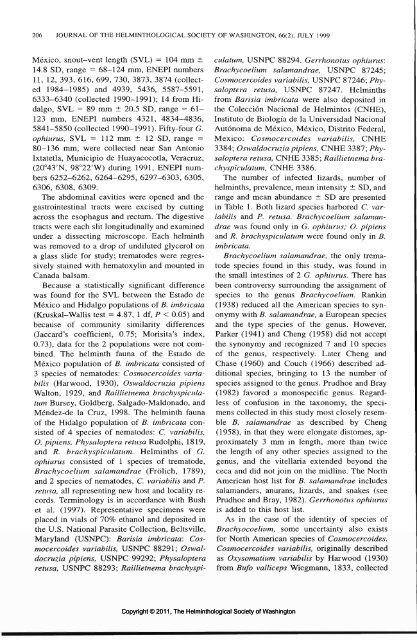The Helminthological Society of Washington - Peru State College
The Helminthological Society of Washington - Peru State College
The Helminthological Society of Washington - Peru State College
You also want an ePaper? Increase the reach of your titles
YUMPU automatically turns print PDFs into web optimized ePapers that Google loves.
206 JOURNAL OF THE HELMINTHOLOGICAL SOCIETY OF WASHINGTON, 66(2), JULY 1999<br />
Mexico, snout-vent length (SVL) =104 mm ±<br />
14.8 SD, range = 68-124 mm, ENEPI numbers<br />
11, 12, 393, 616, 699, 730, 3873, 3874 (collected<br />
1984-1985) and 4939, 5436, 5587-5591,<br />
6333-6340 (collected 1990-1991); 14 from Hidalgo,<br />
SVL = 89 mm ± 20.5 SD, range = 61-<br />
123 mm, ENEPI numbers 4321, 4834-4836,<br />
5841-5850 (collected 1990-1991). Fifty-four G.<br />
ophiurus, SVL = 112 mm ± 12 SD, range =<br />
80-136 mm, were collected near San Antonio<br />
Ixtatetla, Municipio de Huayacocotla, Veracruz,<br />
(20°43'N, 98°22'W) during 1991, ENEPI numbers<br />
6252-6262, 6264-6295, 6297-6303, 6305,<br />
6306, 6308, 6309.<br />
<strong>The</strong> abdominal cavities were opened and the<br />
gastrointestinal tracts were excised by cutting<br />
across the esophagus and rectum. <strong>The</strong> digestive<br />
tracts were each slit longitudinally and examined<br />
under a dissecting microscope. Each helminth<br />
was removed to a drop <strong>of</strong> undiluted glycerol on<br />
a glass slide for study; trematodes were regressively<br />
stained with hematoxylin and mounted in<br />
Canada balsam.<br />
Because a statistically significant difference<br />
was found for the SVL between the Estado de<br />
Mexico and Hidalgo populations <strong>of</strong> B. imbricata<br />
(Kruskal-Wallis test = 4.87, 1 df, P < 0.05) and<br />
because <strong>of</strong> community similarity differences<br />
(Jaccard's coefficient, 0.75; Morisita's index,<br />
0.73), data for the 2 populations were not combined.<br />
<strong>The</strong> helminth fauna <strong>of</strong> the Estado de<br />
Mexico population <strong>of</strong> B. imbricata consisted <strong>of</strong><br />
3 species <strong>of</strong> nematodes: Cosmocercoides variabilis<br />
(Harwood, 1930), Oswaldocruzia pipiens<br />
Walton, 1929, and Raillietnema brachyspiculatum<br />
Bursey, Goldberg, Salgado-Maldonado, and<br />
Mendez-de la Cruz, 1998. <strong>The</strong> helminth fauna<br />
<strong>of</strong> the Hidalgo population <strong>of</strong> B. imbricata consisted<br />
<strong>of</strong> 4 species <strong>of</strong> nematodes: C. variabilis,<br />
O. pipiens, Physaloptera retusa Rudolphi, 1819,<br />
and R. brachyspiculatum. Helminths <strong>of</strong> G.<br />
ophiurus consisted <strong>of</strong> 1 species <strong>of</strong> trematode,<br />
Brachycoelium salamandrae (Frolich, 1789),<br />
and 2 species <strong>of</strong> nematodes, C. variabilis and P.<br />
retusa, all representing new host and locality records.<br />
Terminology is in accordance with Bush<br />
et al. (1997). Representative specimens were<br />
placed in vials <strong>of</strong> 70% ethanol and deposited in<br />
the U.S. National Parasite Collection, Beltsville,<br />
Maryland (USNPC): Barisia imbricata: Cosmocercoides<br />
variabilis, USNPC 88291; Oswaldocruzia<br />
pipiens, USNPC 99292; Physaloptera<br />
retusa, USNPC 88293; Raillietnema brachyspiculatum,<br />
USNPC 88294. Gerrhonotus ophiurus:<br />
Brachycoelium salamandrae, USNPC 87245;<br />
Cosmocercoides variabilis, USNPC 87246; Physaloptera<br />
retusa, USNPC 87247. Helminths<br />
from Barisia imbricata were also deposited in<br />
the Coleccion Nacional de Helmintos (CNHE),<br />
Instituto de Biologia de la Universidad Nacional<br />
Autonoma de Mexico, Mexico, Distrito Federal,<br />
Mexico: Cosmocercoides variabilis, CNHE<br />
3384; Oswaldocruzia pipiens, CNHE 3387; Physaloptera<br />
retusa, CNHE 3385; Raillietnema brachyspiculatum,<br />
CNHE 3386.<br />
<strong>The</strong> number <strong>of</strong> infected lizards, number <strong>of</strong><br />
helminths, prevalence, mean intensity ± SD, and<br />
range and mean abundance ± SD are presented<br />
in Table 1. Both lizard species harbored C. variabilis<br />
and P. retusa. Brachycoelium salamandrae<br />
was found only in G. ophiurus; O. pipiens<br />
and R. brachyspiculatum were found only in B.<br />
imbricata.<br />
Brachycoelium salamandrae, the only trematode<br />
species found in this study, was found in<br />
the small intestines <strong>of</strong> 2 G. ophiurus. <strong>The</strong>re has<br />
been controversy surrounding the assignment <strong>of</strong><br />
species to the genus Brachycoelium. Rankin<br />
(1938) reduced all the American species to synonymy<br />
with B. salamandrae, a European species<br />
and the type species <strong>of</strong> the genus. However,<br />
Parker (1941) and Cheng (1958) did not accept<br />
the synonymy and recognized 7 and 10 species<br />
<strong>of</strong> the genus, respectively. Later Cheng and<br />
Chase (1960) and Couch (1966) described additional<br />
species, bringing to 13 the number <strong>of</strong><br />
species assigned to the genus. Prudhoe and Bray<br />
(1982) favored a monospecific genus. Regardless<br />
<strong>of</strong> confusion in the taxonomy, the specimens<br />
collected in this study most closely resemble<br />
B. salamandrae as described by Cheng<br />
(1958), in that they were elongate distomes, approximately<br />
3 mm in length, more than twice<br />
the length <strong>of</strong> any other species assigned to the<br />
genus, and the vitellaria extended beyond the<br />
ceca and did not join on the midline. <strong>The</strong> North<br />
American host list for B. salamandrae includes<br />
salamanders, anurans, lizards, and snakes (see<br />
Prudhoe and Bray, 1982). Gerrhonotus ophiurus<br />
is added to this host list.<br />
As in the case <strong>of</strong> the identity <strong>of</strong> species <strong>of</strong><br />
Brachyocoelium, some uncertainty also exists<br />
for North American species <strong>of</strong> Cosmocercoides.<br />
Cosmocercoides variabilis, originally described<br />
as Oxysomatium variabilis by Harwood (1930)<br />
from Bufo valliceps Wiegmann, 1833, collected<br />
Copyright © 2011, <strong>The</strong> <strong>Helminthological</strong> <strong>Society</strong> <strong>of</strong> <strong>Washington</strong>
















